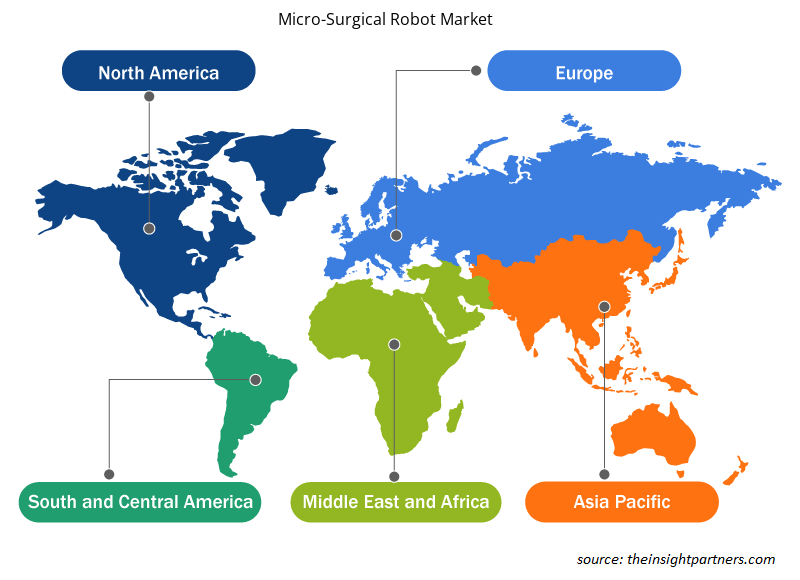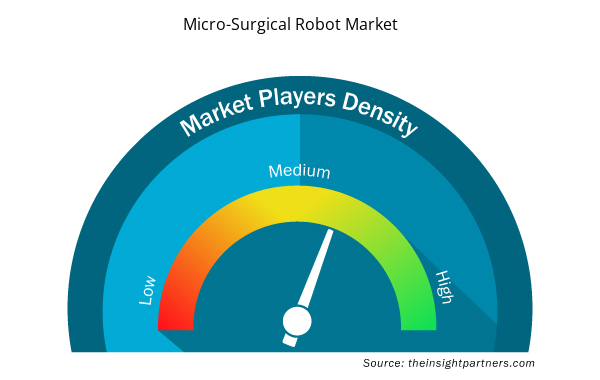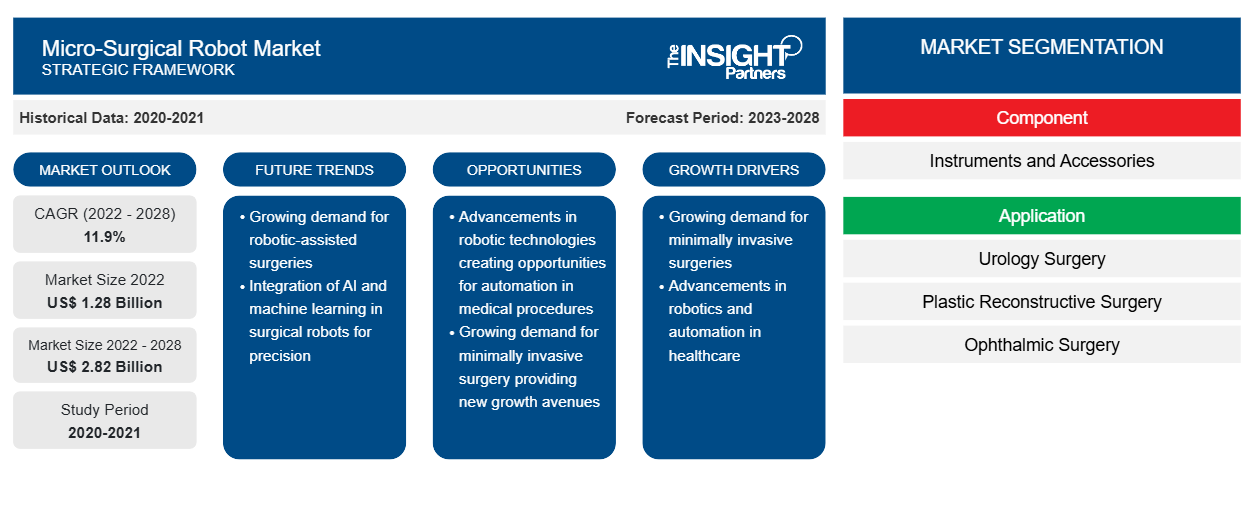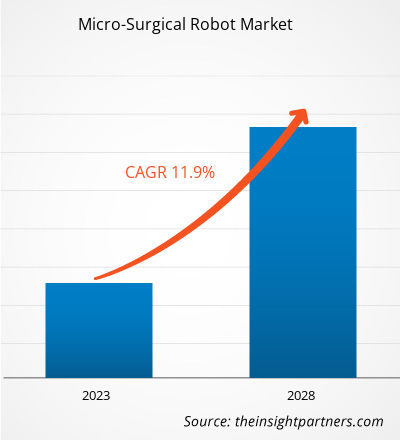微型手术机器人市场预计将从 2022 年的 12.8081 亿美元增长到 2028 年的 28.1757 亿美元;预计 2022 年至 2028 年的复合年增长率为 11.9%。
微型手术机器人用于执行显微手术,即体内和体外手术。机器人可以帮助更灵活、更精确地执行复杂的手术,而这可以通过传统技术实现。微型手术机器人通过微小切口执行微创手术。微型手术机器人的优点是并发症少、疤痕小、失血少、恢复快。微创手术越来越受欢迎,机器人手术在准确性、可重复性、控制和效率方面的优势推动了全球微型手术机器人市场的增长。然而,微型手术机器人的高成本和不同国家不利的报销情况阻碍了市场的增长。
该报告提供了对全球微型手术机器人市场的见解和深入分析,强调了市场趋势、技术进步、市场动态和竞争格局分析等参数,重点关注领先的市场参与者。它还包括 COVID-19 大流行对所有地区市场的影响。许多卫生当局建议通过推迟选择性手术、暂停门诊和对紧急护理中的员工进行分类来避免人际接触,因为传播率不断上升,医疗资源紧张。机器人手术利用人工智能 (AI),它的好处有三个方面:通过在简单任务中提供共享和完全自主权来提高准确性并降低失败风险;通过将外科医生的角色从执行人员改为监督人员,从连续控制人员改为间歇控制人员,允许保持身体距离;增加平均手术次数,这将是解决因长期关闭选择性手术而导致的手术积压问题所必需的。因此,全球微型手术机器人市场在第一波 COVID-19 之后受到了积极影响。
定制此报告以满足您的需求
您可以免费定制任何报告,包括本报告的部分内容、国家级分析、Excel 数据包,以及为初创企业和大学提供优惠和折扣
- 获取此报告的关键市场趋势。这个免费样品将包括数据分析,从市场趋势到估计和预测。
全球微型手术机器人市场根据组件、应用、最终用户和地理位置进行细分。按地理位置划分,市场大致分为北美、欧洲、亚太地区、中东和非洲以及南美和中美洲。
市场洞察
机器人手术在准确性、可重复性、控制和效率方面的优势
机器人手术的引入是脂肪抽吸术的最新进展。外科医生从主控制台控制治疗,而机器人病人推车比腹腔镜系统更轻松、更精确地执行程序。由于其 3D 视觉和准确性以及直观的多范围仪器,机器人手术在脂肪抽吸手术中比传统的腹腔镜手术具有明显的优势,可确保更高的患者安全性。机器人手术还有助于提高缝合能力,减少术后疼痛和恢复时间。对于体重超过 250 公斤的肥胖人士,也建议使用机器人辅助脂肪抽吸术,因为腹腔镜脂肪抽吸术要求更高、难度更大。根据 2020 年发表的一篇文章《机器人综合与传统腹腔镜远端胃切除术结果比较:倾向评分匹配分析》,机器人综合远端胃切除术 (IRDG) 组的成功率为 98%,明显高于传统腹腔镜远端胃切除术 (CLDG) 组的成功率 89.5%。虽然两组的住院和门诊问题发生率相似,但 IRDG 组的再入院率远低于 CLDG 组。此外,机器人手术有助于提高可视化能力,让外科医生更好地观察工作区域,并让他们使用高清摄像头看到微观细节。这些系统比人手更灵活,能够 360° 旋转并更好地导航,让外科医生能够到达难以触及的区域。一个研究小组将氮气驱动的手臂(作为第五个机械臂)与光学放大视频镜头系统(德国图特林根 Karl Storz 公司的 Point-Setter 手臂和 VITOM 镜头)相结合,开发出用于体外机器人显微外科治疗的机器人平台。VITOM 是一种高清外窥镜视频系统,配备用于脊柱手术和儿科手术的光学镜头。该系统的光学放大倍数范围为 16 倍至 25 倍。显微外科医生可以使用外科医生界面中的 TilePro 成像软件,在主 3D 机器人摄像头视图正下方查看来自 VITOM 系统的图像。因此,机器人显微手术可确保更高的准确性、可重复性、控制力和效率。随着人们对更好、更快的医疗服务日益增长的需求,微型手术机器人的这些优势推动了市场增长。
基于组件的洞察
根据组件,全球微型手术机器人市场分为器械和配件。预计到 2022 年,器械部分将占据更大的市场份额。预计该部分市场在预测期内将以更快的复合年增长率增长。CAGR during the forecast period.
基于应用的洞察
根据应用,微型手术机器人市场细分为整形重建手术、耳鼻喉手术、泌尿外科手术、神经外科手术、眼科手术、淋巴手术等。预计到 2022 年,泌尿外科手术领域将占据市场的最大份额。预计同一领域在 2022 年至 2028 年期间的复合年增长率最高。
基于最终用户的洞察
根据最终用户,微型手术机器人市场细分为医院和诊所、门诊手术中心、研究机构等。预计到 2022 年,医院和诊所将占据最大的市场份额。预计同一细分市场将在 2022 年至 2028 年期间实现最高复合年增长率。医院和诊所细分市场微型手术机器人市场的增长归因于手术数量的增加以及这些设施采用先进的设备。
微型手术机器人市场参与者采用产品发布和扩张等有机策略来扩大其全球影响力和产品组合,并满足不断增长的需求。例如,2022 年 5 月,MMI SpA 宣布推出由 VirtaMed 开发的 Symani 手术系统模拟器。
基于地理位置的洞察
按地域划分,全球微型手术机器人市场细分为北美、欧洲、亚太地区 (APAC)、中东和非洲 (MEA) 以及南美洲和中美洲。北美市场进一步细分为美国、加拿大和墨西哥。欧洲微型手术机器人市场细分为法国、德国、英国、西班牙、意大利和欧洲其他地区。亚太地区微型手术机器人市场细分为中国、印度、日本、澳大利亚、韩国和亚太地区其他地区。MEA 市场进一步细分为沙特阿拉伯、阿联酋、南非和 MEA 其他地区。南美洲和中美洲微型手术机器人市场细分为巴西、阿根廷和 SAM 其他地区
微型手术机器人市场区域洞察
Insight Partners 的分析师已详尽解释了预测期内影响微型手术机器人市场的区域趋势和因素。本节还讨论了北美、欧洲、亚太地区、中东和非洲以及南美和中美洲的微型手术机器人市场细分和地理位置。

- 获取微型手术机器人市场的区域特定数据
微型手术机器人市场报告范围
| 报告属性 | 细节 |
|---|---|
| 2022 年市场规模 | 12.8亿美元 |
| 2028 年市场规模 | 28.2亿美元 |
| 全球复合年增长率(2022 - 2028) | 11.9% |
| 史料 | 2020-2021 |
| 预测期 | 2023-2028 |
| 涵盖的领域 | 按组件
|
| 覆盖地区和国家 | 北美
|
| 市场领导者和主要公司简介 |
|
微型手术机器人市场参与者密度:了解其对业务动态的影响
微型手术机器人市场正在快速增长,这得益于终端用户需求的不断增长,这些需求源于消费者偏好的不断变化、技术进步以及对产品优势的认识不断提高等因素。随着需求的增加,企业正在扩大其产品范围,进行创新以满足消费者需求,并利用新兴趋势,从而进一步推动市场增长。
市场参与者密度是指在特定市场或行业内运营的企业或公司的分布情况。它表明在给定市场空间中,相对于其规模或总市场价值,有多少竞争对手(市场参与者)存在。
在微型手术机器人市场运营的主要公司有:
- 德国慕尼黑工业大学
- 微保公司
- 史赛克公司
- 直观外科公司
- 美敦力
免责声明:上面列出的公司没有按照任何特定顺序排列。

- 了解微型手术机器人市场的主要参与者概况
主要公司
MMI SpA;Microsure BV;Stryker Corporation;Intuitive Surgical, Inc.;Medtronic;Galen Robotics, Inc.;Ethicon(强生服务公司);Asensus Surgical, Inc.;Zimmer Biomet;Titan Medical Inc.;以及 ForSight Robotics LTD 是全球微型手术机器人市场的领先公司。
- 历史分析(2 年)、基准年、预测(7 年)及复合年增长率
- PEST 和 SWOT 分析
- 市场规模价值/数量 - 全球、区域、国家
- 行业和竞争格局
- Excel 数据集



Report Coverage
Revenue forecast, Company Analysis, Industry landscape, Growth factors, and Trends

Segment Covered
This text is related
to segments covered.

Regional Scope
North America, Europe, Asia Pacific, Middle East & Africa, South & Central America

Country Scope
This text is related
to country scope.
常见问题
The microsurgical robot market majorly consists of players such as MMI S.p.A.; Microsure B.V.; Stryker Corporation; Intuitive Surgical, Inc.; Medtronic; Galen Robotics, Inc.; Ethicon (Johnson & Johnson Services, Inc.); Asensus Surgical, Inc.; Zimmer Biomet; Titan Medical Inc.; ForSight Robotics LTD.
In 2022, the urology surgery is likely to be hold the largest share of the market, by application. It is expected to report a higher CAGR of 14.3% during 2022–2028.
The instruments segment is likely to be hold a larger market share in 2022 and is expected to continue its dominance during the forecast period. Moreover, the same segment is expected to register a higher CAGR during the forecast period. Major factors driving the market growth for the instruments segment are continuous evolution in the instruments.
The CAGR value of the microsurgical robot market during the forecasted period of 2022–2028 is 11.9%.
Key factors that are driving the growth of this market are the increasing popularity of minimally invasive surgical procedures and advantages of robotic surgeries in terms of accuracy, repeatability, control, and efficiency boost the microsurgical robot market growth.
Micro-Surgical robot are used to perform microsurgeries i.e. intracorporal and extracorporeal Surgical procedures. Robots can assist in performing complex surgical procedure in more flexible and precise manner which cannot be possible with conventional techniques. Micro- surgical robot perform minimally invasive surgical procedures with tiny incisions. The advantages of micro-surgical robot are, fewer complications, small scars, less blood loss and quicker recovery.
Trends and growth analysis reports related to Life Sciences : READ MORE..
The List of Companies - Micro-Surgical Robot Market
- MMI S.p.A.
- Microsure B.V.
- Stryker Corporation
- Intuitive Surgical, Inc.
- Medtronic
- Galen Robotics, Inc.
- Ethicon (Johnson & Johnson Services, Inc.)
- Asensus Surgical, Inc.
- Zimmer Biomet
- Titan Medical Inc.
- ForSight Robotics LTD
The Insight Partners performs research in 4 major stages: Data Collection & Secondary Research, Primary Research, Data Analysis and Data Triangulation & Final Review.
- Data Collection and Secondary Research:
As a market research and consulting firm operating from a decade, we have published and advised several client across the globe. First step for any study will start with an assessment of currently available data and insights from existing reports. Further, historical and current market information is collected from Investor Presentations, Annual Reports, SEC Filings, etc., and other information related to company’s performance and market positioning are gathered from Paid Databases (Factiva, Hoovers, and Reuters) and various other publications available in public domain.
Several associations trade associates, technical forums, institutes, societies and organization are accessed to gain technical as well as market related insights through their publications such as research papers, blogs and press releases related to the studies are referred to get cues about the market. Further, white papers, journals, magazines, and other news articles published in last 3 years are scrutinized and analyzed to understand the current market trends.
- Primary Research:
The primarily interview analysis comprise of data obtained from industry participants interview and answers to survey questions gathered by in-house primary team.
For primary research, interviews are conducted with industry experts/CEOs/Marketing Managers/VPs/Subject Matter Experts from both demand and supply side to get a 360-degree view of the market. The primary team conducts several interviews based on the complexity of the markets to understand the various market trends and dynamics which makes research more credible and precise.
A typical research interview fulfils the following functions:
- Provides first-hand information on the market size, market trends, growth trends, competitive landscape, and outlook
- Validates and strengthens in-house secondary research findings
- Develops the analysis team’s expertise and market understanding
Primary research involves email interactions and telephone interviews for each market, category, segment, and sub-segment across geographies. The participants who typically take part in such a process include, but are not limited to:
- Industry participants: VPs, business development managers, market intelligence managers and national sales managers
- Outside experts: Valuation experts, research analysts and key opinion leaders specializing in the electronics and semiconductor industry.
Below is the breakup of our primary respondents by company, designation, and region:

Once we receive the confirmation from primary research sources or primary respondents, we finalize the base year market estimation and forecast the data as per the macroeconomic and microeconomic factors assessed during data collection.
- Data Analysis:
Once data is validated through both secondary as well as primary respondents, we finalize the market estimations by hypothesis formulation and factor analysis at regional and country level.
- Macro-Economic Factor Analysis:
We analyse macroeconomic indicators such the gross domestic product (GDP), increase in the demand for goods and services across industries, technological advancement, regional economic growth, governmental policies, the influence of COVID-19, PEST analysis, and other aspects. This analysis aids in setting benchmarks for various nations/regions and approximating market splits. Additionally, the general trend of the aforementioned components aid in determining the market's development possibilities.
- Country Level Data:
Various factors that are especially aligned to the country are taken into account to determine the market size for a certain area and country, including the presence of vendors, such as headquarters and offices, the country's GDP, demand patterns, and industry growth. To comprehend the market dynamics for the nation, a number of growth variables, inhibitors, application areas, and current market trends are researched. The aforementioned elements aid in determining the country's overall market's growth potential.
- Company Profile:
The “Table of Contents” is formulated by listing and analyzing more than 25 - 30 companies operating in the market ecosystem across geographies. However, we profile only 10 companies as a standard practice in our syndicate reports. These 10 companies comprise leading, emerging, and regional players. Nonetheless, our analysis is not restricted to the 10 listed companies, we also analyze other companies present in the market to develop a holistic view and understand the prevailing trends. The “Company Profiles” section in the report covers key facts, business description, products & services, financial information, SWOT analysis, and key developments. The financial information presented is extracted from the annual reports and official documents of the publicly listed companies. Upon collecting the information for the sections of respective companies, we verify them via various primary sources and then compile the data in respective company profiles. The company level information helps us in deriving the base number as well as in forecasting the market size.
- Developing Base Number:
Aggregation of sales statistics (2020-2022) and macro-economic factor, and other secondary and primary research insights are utilized to arrive at base number and related market shares for 2022. The data gaps are identified in this step and relevant market data is analyzed, collected from paid primary interviews or databases. On finalizing the base year market size, forecasts are developed on the basis of macro-economic, industry and market growth factors and company level analysis.
- Data Triangulation and Final Review:
The market findings and base year market size calculations are validated from supply as well as demand side. Demand side validations are based on macro-economic factor analysis and benchmarks for respective regions and countries. In case of supply side validations, revenues of major companies are estimated (in case not available) based on industry benchmark, approximate number of employees, product portfolio, and primary interviews revenues are gathered. Further revenue from target product/service segment is assessed to avoid overshooting of market statistics. In case of heavy deviations between supply and demand side values, all thes steps are repeated to achieve synchronization.
We follow an iterative model, wherein we share our research findings with Subject Matter Experts (SME’s) and Key Opinion Leaders (KOLs) until consensus view of the market is not formulated – this model negates any drastic deviation in the opinions of experts. Only validated and universally acceptable research findings are quoted in our reports.
We have important check points that we use to validate our research findings – which we call – data triangulation, where we validate the information, we generate from secondary sources with primary interviews and then we re-validate with our internal data bases and Subject matter experts. This comprehensive model enables us to deliver high quality, reliable data in shortest possible time.


 获取此报告的免费样本
获取此报告的免费样本